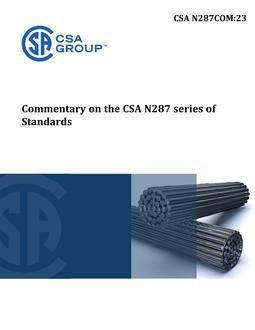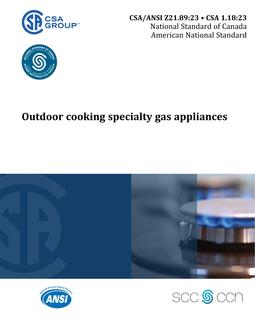
CSA W186:21
- Comments Off on CSA W186:21
- CSA
Click here to purchase
Preface:
This is the fourth edition of CSA W186, Welding of reinforcing bars in reinforced concrete construction. It supersedes the previous editions published in 1990, 1981, and 1970.
Several clauses have been updated extensively and there have been additions as well. The revisions were made to reflect the experience and knowledge gained during recent years. An important consideration was to ensure that this Standard continues to relate to the limit states (load factor) design.
The new items introduced in this edition relate to the X-ray method for non-destructive examination of direct butt joints and the introduction of non-load-bearing joints.
This Standard deals with the certification of companies for fusion welding of reinforcing bars, weld design, fabrication, and inspection of welds of reinforcing bars in reinforced concrete construction. It is not a product Standard and cannot be used to evaluate or approve products. It is not intended to supersede Codes and Standards that govern specific products.
This Standard stipulates minimum requirements that a company must meet and adhere to in order to obtain and maintain certification. Certification is granted by the Canadian Welding Bureau (CWB), the administrative body for this Standard, to companies that comply with the requirements of this Standard. Certification of a company indicates that, consistent with the requirements of the division in which the company is certified, it has the organization, personnel, welding procedures, and equipment required to produce satisfactory welds and weldments.
Production of satisfactory welds and weldments is the responsibility of the certified company. It is the responsibility of the purchaser to ensure, through adequate inspection, that the required quality is attained. Although the CWB makes periodic inspections of certified companies to ensure that they continue to comply with the requirements of this Standard, these inspections do not eliminate the need for a certified company’s quality control methods or a purchaser’s comprehensive inspection program.
Scope:
1.1
This Standard governs the certification of companies. Certification pertains to the capability of the company with respect to welding. Certification should not be construed as approving any products or services of the certified company.
Note: The requirements of this Standard are based on the principle that a certified company has full responsibility for the quality of the welded product it produces, and this responsibility cannot be transferred to its employed or retained personnel or to the administrator of this Standard.
1.2
This Standard provides the requirements for the
a) certification of companies engaged in the fusion welding of reinforcing bars and the qualification of their personnel and welding procedures;
b) the design, fabrication, and inspection of welded connections utilizing deformed reinforcing bars; c) welding of deformed reinforcing bars either directly to each other or through splice members; and d) welding of deformed reinforcing bars to structural or low-alloy steel members used as anchorages in precast or cast-in-place concrete construction either in the fabricating shop or in the field.
In lieu of meeting requirements of this Standard, companies performing welding of reinforcing bars to steel elements may apply testing requirements of CSA W47.1 and have their welding personnel and welding procedures accepted with CSA W47.1.
Note: Some examples of applications that can apply certification of CSA W47.1 are welding of deformed bars (anchors) to structural or hardware elements when installing precast panels to buildings, lifting devices, base plates, ladders, catwalks, etc. Whenever the welding of reinforcing rebars is required to reinforce the concrete in applications like concrete, precast, cast in place construction, etc., provisions of CSA W186 apply. Applications required by the following standards require certification to this standard: CSA A448.1, A23.1, A23.3, A23.4, N287.2, N287.3, N287.4, N287.5, S304.1, S6, S474, S850, and Z98.
1.3
This Standard stipulates requirements for
a) welding engineers;
b) welding supervisors;
c) welders and welding operators; and
d) documentation.
Notes:
1) The qualification requirements for welders, and welding operators specified in this Standard are intended to demonstrate an individual’s basic welding skills and to provide a means of verifying that individual’s continuing ability in the fusion welding of steel.
2) Provisions for recognition of personnel qualified under other jurisdictions are included in this Standard.
1.4
This Standard includes provisions for the following:
a) shielded metal arc welding (SMAW);
b) gas metal arc welding (GMAW);
c) flux-cored arc welding (FCAW);
d) metal-cored arc welding (MCAW); and
e) gas tungsten arc welding (GTAW).
1.5
This Standard does not cover requirements for the
a) welding of plates, angles, or other structural members to one another. These types of applications are covered by CSA W59;
b) welding of deformed reinforcing bars used for pre-stressing steel or for bar or rod mats for which the welding is covered by the manufacturing specification; and
c) welding reinforcing bars with specified yield strength exceeding 550 MPa (80 ksi).
1.6
This Standard does not address the safety issues associated with welding and welding practices.
Note: CSA W117.2 addresses safety in welding and should be followed, in addition to any applicable workplace health and safety legislation in effect. It is the responsibility of the user of this Standard to establish appropriate safety and health practices and determine the applicability of regulatory limitations prior to use.
1.7
This Standard does not address underwater welding activities.
1.8
This Standard does not address the welding of stainless steel.
1.9
In this standard, “shall” is used to express a requirement, i.e., a provision that the user is obliged to satisfy in order to comply with the Standard; “should” is used to express a recommendation or that which is advised but not required; and “may” is used to express an option or that which is permissible within the limits of the Standard. Notes accompanying clauses do not include requirements or alternative requirements; the purpose of a note accompanying a clause is to separate from the text explanatory or informative material. Notes to tables and figures are considered part of the table or figure and may be written as requirements. Annexes are designated normative (mandatory) or informative (non-mandatory) to define their application.
1.10
The values given in SI units are the units of record for the purposes of this Standard. The values given in parentheses are for information and comparison only.
Product Details
- Edition:
- 4th
- Published:
- 03/01/2021
- ISBN(s):
- 9781488322716
- Number of Pages:
- 140
- File Size:
- 1 file , 2.4 MB
- Product Code(s):
- 2427317, 2428585, 2427317



